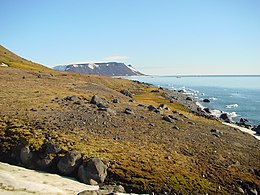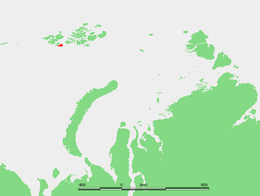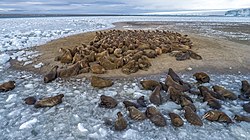Northbrook Island
остров Нортбрук | |
|---|---|
 A coastal view of Northbrook Island | |
 Location of Northbrook Island in the Franz Josef Archipelago | |
| Geography | |
| Location | Arctic |
| Coordinates | 79°54′N 50°54′E / 79.9°N 50.9°E |
| Archipelago | Franz Josef Archipelago |
| Area | 1,050 km2 (410 sq mi) |
| Length | 22.4 km (13.92 mi) |
| Width | 19.2 km (11.93 mi) |
| Highest elevation | 344 m (1129 ft) |
| Administration | |
| Demographics | |
| Population | 0 |

Northbrook Island (Russian: остров Нортбрук) is an island located in the southern edge of the Franz Josef Archipelago, Russia. Its highest point is 344 m.
Northbrook Island is one of the most accessible locations in the island group. Thus it often served as a base for polar expeditions in the late 19th and early 20th centuries.
This island was named after the Earl of Northbrook, who was president of the Royal Geographical Society between 1890 and 1893. The naming of the island was partly due to the insistence of Nikolai Góring, who was among the Earl's entourage during his presidential term.
History
Cape Flora, located in an unglacierized area in the Southwest of Northbrook Island (79°57′N 50°05′E) camp is historically significant. British yachtsman and explorer Benjamin Leigh Smith was shipwrecked at Cape Flora in 1881. A chance encounter between explorers Fridtjof Nansen and Frederick George Jackson took place here in 1896. Jackson was leading the Jackson–Harmsworth expedition, based at Cape Flora, when this meeting occurred, on 17 June 1896.[1]
A cape to the north of the island, at 80°55'N, was named Cape Bruce, after Scottish zoologist and oceanographer William Speirs Bruce, a member of the Jackson–Harmsworth expedition.[2] In 1904, coal was mined about 150 metres (492 feet) up the slopes by explorers of the American Ziegler Polar expedition wintering over after their ship sank at Rudolf Island.
After a gruesome ordeal, navigator Valerian Albanov and sailor Alexander Konrad, the sole survivors of the ill-fated expedition of the Svyataya Anna, ended up on Cape Flora in 1914. Albanov and Konrad were ultimately rescued by the Svyatoy Foka as they were preparing for the winter.[3]
Adjacent islands
- Ostrov Robertsona (Остров Робертсона), Robertson Island is a small island lying right off Northbrook Island's eastern shore, close to its easternmost point. This island was named after Scottish Antarctic explorer Captain Thomas Robertson of the 1904 the Scottish National Antarctic Expedition to the South Orkney Islands on ship Scotia.
- Ostrov Novyy[citation needed] lies less than 2 km to the SSW of Robertson, closer to the shore. Both islands are less than 1 km in length.
References
Sources
- Speak, Peter: William Speirs Bruce NMS Publishing, Edinburgh 2003 ISBN 1-901663-71-X
- All locations: [1]
- Captain Thomas Robertson: [2], [3] [4] & [5]
External links
 Media related to Northbrook Island at Wikimedia Commons
Media related to Northbrook Island at Wikimedia Commons- Cape Flora, Northbrook Island on Bloosee
